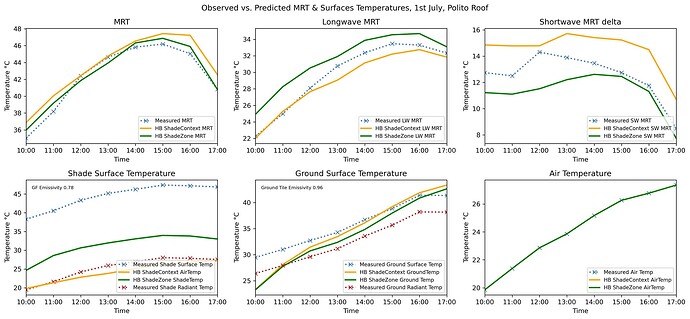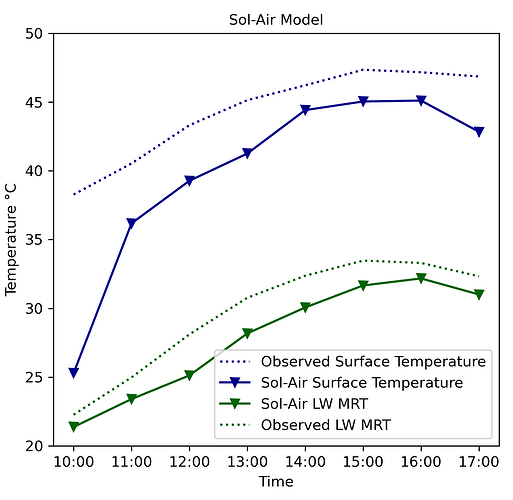Following up on this. I have some very good agreement with my field measurements except for the shortwave MRT and shade surface which I explain more below, but in brief I’m wondering if I can improve the sw mrt through radiance parameters and I want to confirm does the UTCI component consider emissivity in the longwave MRT calculation?
SW Delta - I tried different combinations of -ab -ad and -lw after learning from here (Radiance Parameters for Daylight Analysis - #7 by sarith) that these are the 3 most important radiance parameters for the rflux setting. I could only get stable results when -ab was above 5, but the SW MRT was overestimated in both cases, by up to 8C. To get results close to the measured SW MRT i had to limit -ab to 2 but despite trying many combinations of -ad and -lw with it, it still ended up varying by up to 5 degrees between simulation runs. I guess that some of the issue is because i only have one sensor point and so it’s very sensitive to variance but is there anything else i can try to make this more stable? And am i right in thinking that the effect of shortwave radiation is being overestimated either by the way I’ve set the radiance parameters or in the actual calculation of sw mrt? It seems to agree with some other studies i’ve come across e.g Redirecting, Redirecting, Redirecting)
Surface Temps - LW MRT is closest in the shade as context model because it assumes the shade surface is the same as air temperature. The shade’s measured radiant temperature is close to air temperature so this works out in the simulation.
BUT - the shade material has a measured emissivity of 0.78, so when I calculated the actual surface temperature (Stefan-Boltzman’s Law : P/A = є σ T^4), it’s much higher than what is being simulated. When i model the shade as a thermal zone, the temperature was a few degrees higher than the measured radiant temperature as I would expect leading to a higher LW MRT.
When i did everything manually- calculating the shade surface temperature with the Tsol-air equation and irradiance values and view factors from the UTCI components, the resulting surface temperature is much closer to that measured. Then when i calculated LW MRT manually but including material emissivity values in the equation i get a fairly close LW MRT to that measured also.
So im trying to understand what’s going on - the ShadeContext model works in this case because the radiant temperature of the shade is close to air temperature. The ShadeZone model is a bit overestimated because the simulated surface is a few degrees higher than radiant temp and no emissivity is included in the LW MRT calculation. It kind of works for this case study but if i was modelling a surface with high solar absorption and low emissivity (i.e like some photovoltaics) it would be quite inaccurate. It’s a very specific use case but i’m interested in understanding how i might used LBT to test various ‘non-standard’ lighweight materials like pv’s or radiant cooling materials, and design optimised shade.

